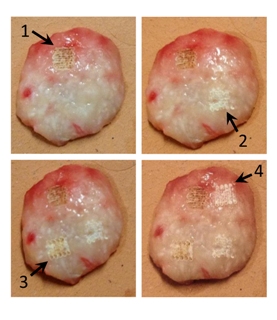Feb 13 2015
Surgeons rely on 200-year-old techniques based on sight and touch when removing cancer, to determine how much to remove and what to leave alone. Laser technology pioneered at Florida Atlantic University has the promise to help a surgeon better determine if an area is cancer or healthy tissue. Moreover, when combined with laser treatment for cancer, this work lays the groundwork for laser robotic treatment of cancer.
 Squamous cell carcinoma showing different areas of ablation treatment (numbered). Treated areas were probed with laser Raman spectroscopy to assess the residual tissue. The ablation laser works in a grid pattern and pictured in the photos are the results of four different ablation treatment levels. Credit: Charles E. Schmidt College of Science, Florida Atlantic University
Squamous cell carcinoma showing different areas of ablation treatment (numbered). Treated areas were probed with laser Raman spectroscopy to assess the residual tissue. The ablation laser works in a grid pattern and pictured in the photos are the results of four different ablation treatment levels. Credit: Charles E. Schmidt College of Science, Florida Atlantic University
Raman spectroscopy is an invaluable tool used by scientists for bioimaging and tissue diagnosis. In a study recently published in Lasers in Surgery and Medicine Journal, scientists and physicians in the Charles E. Schmidt College of Science at Florida Atlantic University have broadened the applicability of Raman spectroscopy by showing that it can be used to distinguish normal from cancerous residual skin tissue following high-powered laser ablation. This is the first time that Raman spectroscopy has been successfully used to detect cancerous tissue following laser ablation, setting the stage to use this technique as a guide for laser surgery. Scientists hope to one day employ Raman spectroscopy clinically in tandem with laser-ablative removal of skin cancers and possibly even other forms of cancers as well.
“I think the most important finding of this study for dermatologists and their patients is that it demonstrates the feasibility of a potentially much faster and more accurate mode of skin cancer treatment based entirely on laser technology,” said Andrew C. Terentis, Ph.D., lead scientist of the study and an associate professor of chemistry and biochemistry in FAU’s Charles E. Schmidt College of Science.
Cancerous tissue is diagnosed using a Raman laser and the cancerous tissue is removed in a very precise, localized fashion using an ablation laser. This type of Raman-based technique for skin cancer diagnosis and treatment, although not yet fully developed, may one day obviate the need for a more costly and time-consuming treatment method like Mohs micrographic surgery, at least in some, if not all, clinical cases.
This study combined laser ablation for highly precise, hemostatic removal of cancerous tissue, with Raman spectroscopy to objectively and non-destructively probe the ablated tissue area in situ for any remaining cancer to remove. Raman spectra were collected from partially-ablated normal and squamous cell carcinoma samples and a spectral classification model based on principal component analysis with logistic regression correctly identified spectra from residual cancerous tissue with 95 percent sensitivity and 100 percent specificity.
“Successful clinical implementation of the proposed surgical method could greatly enhance the speed and effectiveness of skin cancer treatment, especially if real-time analysis of the process were developed,” said Terentis.
Mohs micrographic surgery is currently the gold-standard technique for skin cancer removal because it provides high cure rates while removing the least amount of healthy tissue. However, it is time consuming, resource-intensive, and the intraoperative evaluation of the excised tissue sections by histopathology is subjective. With Mohs surgery, the physician serves as surgeon, pathologist and reconstructive surgeon and relies on the accuracy of a microscope to trace and ensure removal of skin cancer down to its roots. This procedure allows dermatologists, trained in Mohs Surgery, to see beyond the visible disease, and to precisely identify and remove the entire tumor, leaving healthy tissue unharmed.
Terentis’ collaborators include co-author John Strasswimmer, M.D., Ph.D., affiliate faculty in FAU’s Charles E. Schmidt College of Medicine, and a skin cancer specialist and director of the Melanoma and Cutaneous Oncology Program at the Lynn Cancer Institute and Moffitt Cancer Network. Partial funding was provided by the Sinai Hospital of Detroit.
“When a surgeon removes a cancer, whether it be with Mohs surgery for skin cancer or a surgeon using a robot in a modern operating room for abdominal cancer, the surgeon must rely on vision and touch to help decide initially how much tissue to remove,” said Strawswimmer. “This new work with professor Terentis sets the stage for us to have an automatic laser to vaporize cancer and the Raman spectroscopy to tell us when to stop the vaporization process. This is particularly important in areas that we can access with the laser beam such as the lungs or inside the liver that are otherwise very difficult to access with traditional surgery. We designed this study with skin cancer, because it is a very straightforward model study and the number of skin cancer patients is increasing at an exponential rate.”
According to the American Academy of Dermatology, current estimates are that one in five Americans will develop skin cancer in their lifetime. More than 3.5 million cases of non-melanoma skin cancer, including basal cell carcinoma and squamous cell carcinoma, are diagnosed in more than 2 million people in the United States every year. It is estimated that 137,310 new cases of melanoma, 63,440 noninvasive (in situ) and 73,870 invasive, will be diagnosed in 2015. This year, it is estimated that one in 50 Americans will develop melanoma in their lifetime.